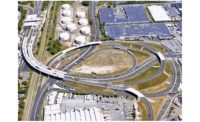Complex Configuration
Thiel described the design as complex because of the ramps weaving in and over the turnpike and I-195, both of which must remain open to traffic. There will be six stages of traffic detours during construction.
“We are temporarily widening one of the existing I-195 bridges over the turnpike to maintain traffic while we lengthen the other bridge, then we are switching traffic while we demolish the temporary bridge and build a new one,” Thiel says.
Connecting the inner roadway to the toll plazas requires long structures with outriggers that span the outer lanes, Thiel adds.
T.Y. Lin International | Medina, Hackettstown, N.J., designed Section 5, which includes five miles of road widening and seven local steel-girder bridges over the turnpike. Wetlands, endangered species, state-owned recreation property and other environmental concerns led the firm to add retaining walls and guide rails and steeper side slopes to reduce impacts.
“We minimized the footprint of the improvements touching on some of the environmentally sensitive areas,” says Robert Medina, senior vice president of T.Y. Lin.
To maintain a natural stream bottom—and fish passage—T.Y. Lin designed three-sided, rigid-frame culverts. Construction crews drove sheeting to excavate the footings while maintaining the stream flow. The two vertical walls sit on footings with a horizontal slab across the top. This section also includes tunneling of drainage pipe beneath the turnpike.
The 1.8-mile Section 6, designed by Dewberry, Fairfax, Va., features the new single-point urban Interchange 8 and a new 10-lane toll plaza, with a toll-collector utility and equipment building expected to receive LEED certification. It includes energy-conserving features and recycled and local materials. Ali Vaezi, senior vice president of Dewberry, says the single-point urban interchange is the first to be built in New Jersey. The 250-ft-long steel bridge spans Route 33.
“We were able to get an efficient intersection below the structure,” Vaezi says. It has “one set of signals for all of the movement, essentially.”
Arora and Associates, Lawrenceville, N.J., designed Section 7, which includes a mainline bridge spanning a Conrail rail line and the Hightstown-Cranbury Station Road at a severe skew angle of almost 75 degrees.
“This large skew angle required design of outer roadway structures that are 900 feet long to cross the two-lane roadway and railroad that combined is only 66 feet wide,” says Dan Yacovino, project manager for Arora. “As the design moved forward, the NJTA made the decision to replace the existing inner roadway structures.”
Edwards & Kelcey, now Jacobs, Morristown, N.J., designed Section 8, a 12-mile section that begins three miles south of Interchange 8A and extends north to Interchange 9. The firm will also design the reconstruction, modification or replacement of six bridges and two culverts. The bridgework includes two local road crossings and a structure to accommodate a U-turn for the New Jersey State Police Barracks near the Molly Pitcher Service Area. The last large construction contract, valued at $148 million, will be advertised this fall for work in this section.
Scheduling And Tracking
Williams says the greatest challenge is managing the documentation. Electronic programs have helped the turnpike authority and its legal, engineering and construction teams keep track of the project—from right-of-way acquisition through construction.
“There’s a tremendous amount to be watching,” Williams says. “Doing it electronically saves time and money and gives real-time access to multiple people.”
Shaw construction inspectors document daily construction activities on tablets in the field using a Field Automated Communication System. The tablets contain all of the construction plans and specifications. Resident engineers review and approve daily reports before entering them into a custom built Integrated Project Management Information System, called iPMIS.
“I can take a look at schedule, at cost and overall contract completion in basically one area,” O’Connor says. “It’s been a very useful system.”
In addition to the Web-based iPMIS, teams are using Primavera P6 scheduling software to help coordinate daily lane closings. All contractors are required to use the software. The authority determines closures on a weekly basis.
“High-level staff look at contractors’ requests, map it out and determine who should have priority for the good of the project,” Williams says. “We look at how one contract affects others and the entire program.”
That schedule is available for all of the contractors and construction managers.
“We’re doing well budget wise [and] on schedule,” Williams says. “We’re right where we need to be.”
Article toolbar
